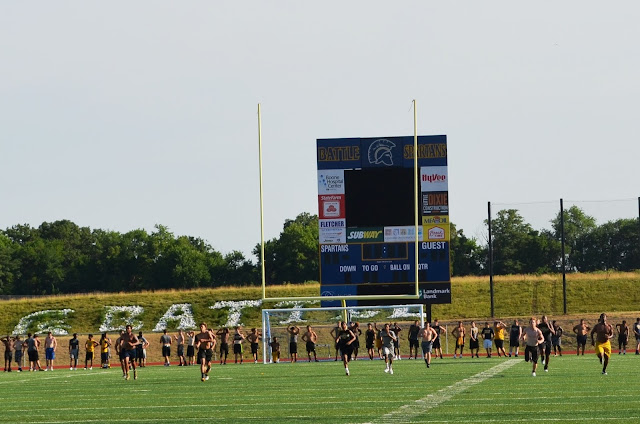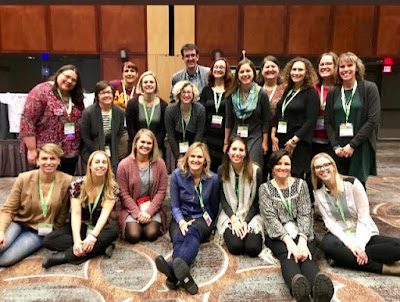Endurance Part 1: Why We Must Build Endurance in Our Readers & Writers
I love coming to summer school on these June mornings and seeing so many of our athletes hard at work. On the football field, sweat-drenched players sprint the length of the field in the coolest part of a Missouri summer day. Cross country runners, just back from a 7-mile run, stretch out and cool down on the cement sidewalk.
Good coaches know that at the beginning of the season, they have to build endurance in their athletes, push them to challenge themselves, to get stronger, more agile, faster, and better at each practice. Cross country didn't start with a 7-mile run; they built to a 7-mile run. Varsity football looks different than freshmen football.
The athletes I watch today are in those difficult practices by choice. They want to score the winning touchdown, to go to State this year. They want to break personal bests and to win races in cross country meets. And still, even though they have chosen their sport, not all of these athletes will last the season. Some will quit because it's too hard; some because grades aren't good enough; and some because of family and work obligations.
Now think about the classroom. As teachers, we want the same dedication and work ethic in our classes. We want students who are motivated, determined, and willing to go above and beyond in their effort. We want good attitudes, an "I'll try" mentality, a smile every now and then. We want heads up off the desks, minds engaged, curious, alert, and questioning.
If your class is like mine, however, students did not choose it like they did their favorite sport. I've only ever taught required classes like English and reading intervention. So the student are assigned to me. The big question then is, can we expect growth and endurance to develop in readers and writers who resist? Can we expect them to work hard, to dive in and tackle rigorous tasks when they don't even want to be sitting in that desk? What if they have the worst home life ever? What if they really are lazy? What if they really have NO motivation, NO grit, NO desire to learn? Should we just work hard, hoping one day to get one of the "dream" teaching positions, where all the kids are bright, motivated and share our love of all things ELA?
The answer to all those questions (except requesting that new teaching assignment...) is an absolute, resounding YES. Yes, we can expect growth and endurance. Yes, we can expect hard work and tackling rigorous challenges. Yes. Yes. Yes.
But expecting is not enough. Ever. We must consciously plan, teach and expect in order to succeed. We must first think about building capacity for success. A coach must first know his or her sport. What skills and abilities need to be cultivated for athletes to be successful? And then, the coach must know each athlete on the team. Who would best fit each position? One size does not fit all kids. The football coach does not expect everyone to kick field goals; nor is everyone going to be a lineman. During those early practices, the coaches scrutinize players, figuring out who is good at what, and what talents can be cultivated into real strengths for the team.
Here are two things teachers must do as groundwork to create an endurance culture:
1. Clarify for yourself what foundations need to be in place for students to be successful readers and writers. The cross country coach has some simple non-negotiables: endurance and speed. The football coach has his own set. Teachers must define for themselves which foundations, skills, and attributes must be in place in order for students to learn in their class. I'm not talking content; I'm talking about the skills to access the content. I'm not talking spelling and grammar. I'm talking about the essentials that will enable students to succeed.
We can start by asking ourselves two questions:
1) What skills and strengths must I build in students?
2) What structures must be in place in my classroom?
In my class, students must be able to:
- feel comfortable enough to take risks
- choose just-right books
- focus and sustain reading attention for extended periods of time
- think and reflect on what is being read through talk and writing
- generate topics they are interested in
- focus and capture thinking on paper
My classroom must provide:
- time to read and write
- ownership over book selection and writing topics and format
- response from me and from classmates to help the student
These classroom structures are straight out Nancie Atwell's In the Middle. For me, there is nothing truer or simpler. These three acknowledge that the autonomous readers and writers, not the teacher, not the curriculum, are at the center of our class.
2. Get to know your students. Just like the coach watching the players for their strengths and needs, we too need to be researchers in our classroom, getting know our students.
- We first need to know them as people. What are they interested in? What do they love and hate? Who are their family and friends? What experiences have they had?
- We also need to know them as learners. What is their history with reading and writing? What strengths and needs to they have? How do they feel about these subjects?
We can do a lot in our classrooms early on to get to know kids - talking with them, having them talk with each other, reading the writing they create in their notebooks, interest surveys, formative assessments, past data. Using a variety of formal and informal sources, we need to be purposeful in constructing a multi-dimensional view of our students. We want to be careful we know who each student is, not who we decide they are.
These two layers of building endurance are not optional. Before school begins, we must be absolutely clear on what skills will be needed and then create a plan for developing them. And, we must create a plan and commit to knowing our students well.
Part 2 of this series addresses how we build the skills of endurance into our class from the first day of school. I'd love to hear from others about how they build capacity in their students. Like all teaching, this requires constant reflection and fine-tuning over time.






Comments
Post a Comment